The AMD Radeon R9 290X Review
by Ryan Smith on October 24, 2013 12:01 AM EST- Posted in
- GPUs
- AMD
- Radeon
- Hawaii
- Radeon 200
Compute
Jumping into pure compute performance, we’re going to have several new factors influencing the 290X as compared to the 280X. On the front end 290X/Hawaii has those 8 ACEs versus 280X/Tahiti’s 2 ACEs, potentially allowing 290X to queue up a lot more work and to keep itself better fed as a result; though in practice we don’t expect most workloads to be able to put the additional ACEs to good use at the moment. Meanwhile on the back end 290X has that 11% memory bandwidth boost and the 33% increase in L2 cache, which in compute workloads can be largely dedicated to said computational work. On the other hand 290X takes a hit to its double precision floating point (FP64) rate versus 280X, so in double precision scenarios it’s certainly going to enter with a larger handicap.
As always we'll start with our DirectCompute game example, Civilization V, which uses DirectCompute to decompress textures on the fly. Civ V includes a sub-benchmark that exclusively tests the speed of their texture decompression algorithm by repeatedly decompressing the textures required for one of the game’s leader scenes. While DirectCompute is used in many games, this is one of the only games with a benchmark that can isolate the use of DirectCompute and its resulting performance.
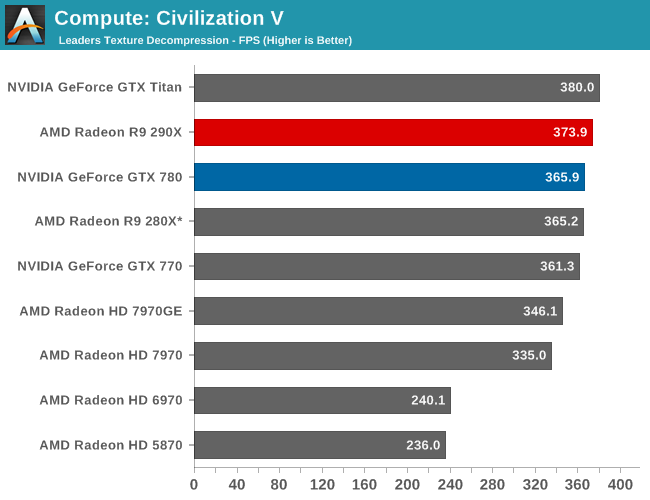
Unfortunately Civ V can’t tell us much of value, due to the fact that we’re running into CPU bottlenecks, not to mention increasingly absurd frame rates. In the 3 years since this game was released high-end CPUs are around 20% faster per core, whereas GPUs are easily 150% faster (if not more). As such the GPU portion of texture decoding has apparently started outpacing the CPU portion, though this is still an enlightening benchmark for anything less than a high-end video card.
For what it is worth, the 290X can edge out the GTX 780 here, only to fall to GTX Titan. But in these CPU limited scenarios the behavior at the very top can be increasingly inconsistent.
Our next benchmark is LuxMark2.0, the official benchmark of SmallLuxGPU 2.0. SmallLuxGPU is an OpenCL accelerated ray tracer that is part of the larger LuxRender suite. Ray tracing has become a stronghold for GPUs in recent years as ray tracing maps well to GPU pipelines, allowing artists to render scenes much more quickly than with CPUs alone.
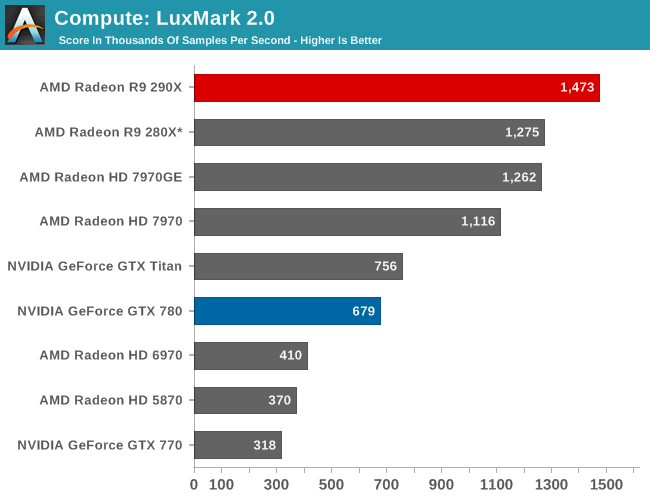
LuxMark by comparison is very simple and very scalable. 290X packs with it a significant increase in computational resources, so 290X picks up from where 280X left off and tops the chart for AMD once more. Titan is barely half as fast here, and GTX 780 falls back even further. Though the fact that scaling from the 280X to 290X is only 16% – a bit less than half of the increase in CUs – is surprising at first glance. Even with the relatively simplistic nature of the benchmark, it has shown signs in the past of craving memory bandwidth and certainly this seems to be one of those times. Feeding those CUs with new rays takes everything the 320GB/sec memory bus of the 290X can deliver, putting a cap on performance gains versus the 280X.
Our 3rd compute benchmark is Sony Vegas Pro 12, an OpenGL and OpenCL video editing and authoring package. Vegas can use GPUs in a few different ways, the primary uses being to accelerate the video effects and compositing process itself, and in the video encoding step. With video encoding being increasingly offloaded to dedicated DSPs these days we’re focusing on the editing and compositing process, rendering to a low CPU overhead format (XDCAM EX). This specific test comes from Sony, and measures how long it takes to render a video.
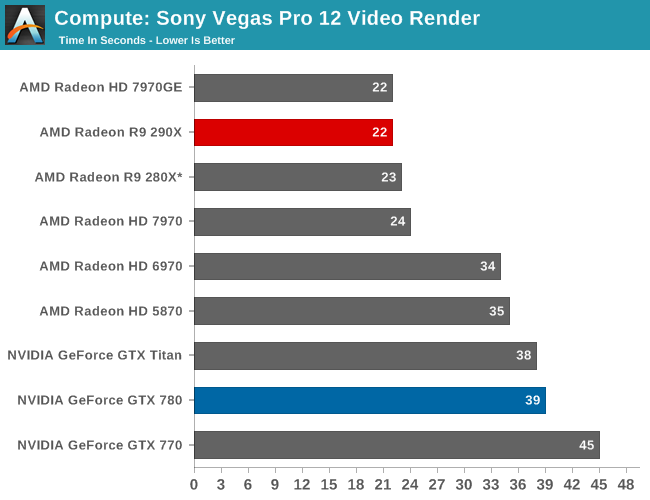
Vegas is another title where GPU performance gains are outpacing CPU performance gains, and as such earlier GPU offloading work has reached its limits and led to the program once again being CPU limited. It’s a shame GPUs have historically underdelivered on video encoding (as opposed to video rendering), as wringing significantly more out of Vegas will require getting rid of the next great CPU bottleneck.
Our 4th benchmark set comes from CLBenchmark 1.1. CLBenchmark contains a number of subtests; we’re focusing on the most practical of them, the computer vision test and the fluid simulation test. The former being a useful proxy for computer imaging tasks where systems are required to parse images and identify features (e.g. humans), while fluid simulations are common in professional graphics work and games alike.
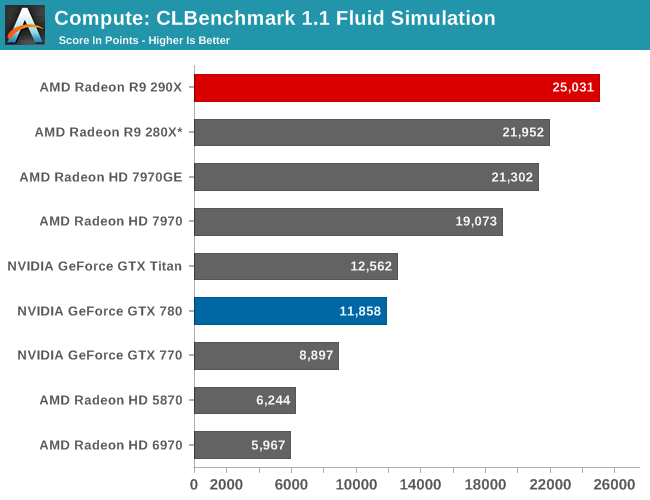
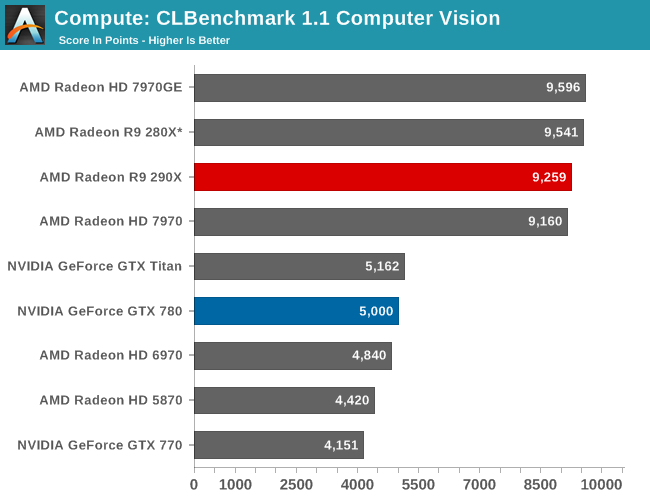
Curiously, the 290X’s performance advantage over 280X is unusual dependent on the specific sub-test. The fluid simulation scales decently enough with the additional CUs, but the computer vision benchmark is stuck in the mud as compared to the 280X. The fluid simulation is certainly closer than the vision benchmark towards being the type of stupidly parallel workload GPUs excel at, though that doesn’t fully explain the lack of scaling in computer vision. If nothing else it’s a good reminder of why professional compute workloads are typically profiled and optimized against specific target hardware, as it reduces these kinds of outcomes in complex, interconnected workloads.
Moving on, our 5th compute benchmark is FAHBench, the official Folding @ Home benchmark. Folding @ Home is the popular Stanford-backed research and distributed computing initiative that has work distributed to millions of volunteer computers over the internet, each of which is responsible for a tiny slice of a protein folding simulation. FAHBench can test both single precision and double precision floating point performance, with single precision being the most useful metric for most consumer cards due to their low double precision performance. Each precision has two modes, explicit and implicit, the difference being whether water atoms are included in the simulation, which adds quite a bit of work and overhead. This is another OpenCL test, as Folding @ Home has moved exclusively to OpenCL this year with FAHCore 17.
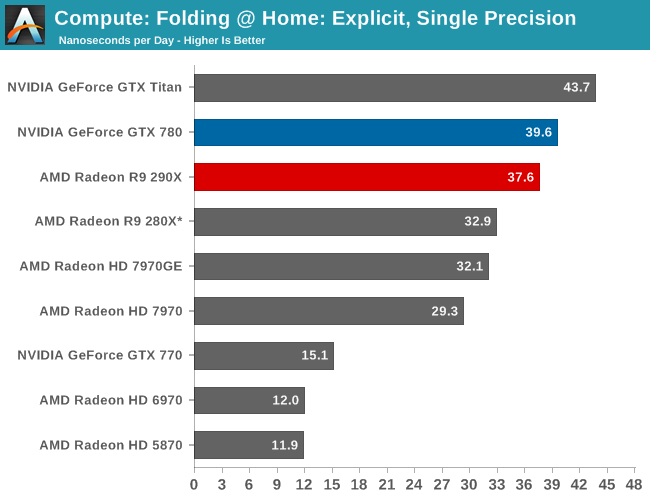
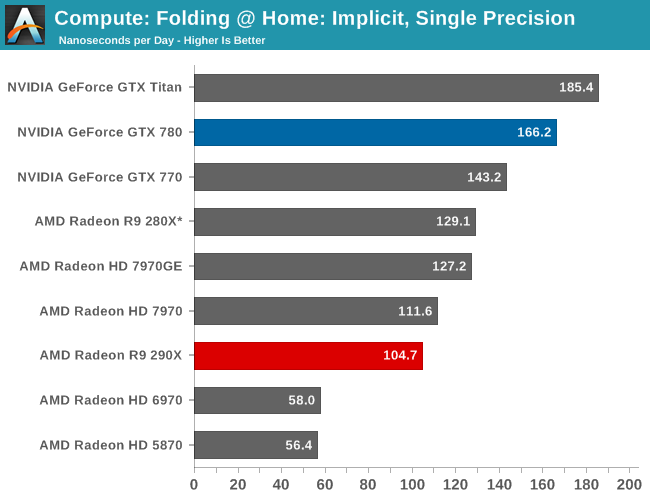

With FAHBench we’re not fully convinced that it knows how to best handle 290X/Hawaii as opposed to 280X/Tahiti. The scaling in single precision explicit is fairly good, but the performance regression in the water-free (and generally more GPU-limited) implicit simulation is unexpected. Consequently while the results are accurate for FAHCore 17, it’s hopefully something AMD and/or the FAH project can work out now that 290X has been released.
Meanwhile double precision performance also regresses, though here we have a good idea why. With DP performance on 290X being 1/8 FP32 as opposed to ¼ on 280X, this is a benchmark 290X can’t win. Though given the theoretical performance differences we should be expecting between the two video cards – 290X should have about 70% of the FP 64 performance of 280X – the fact that 290X is at 82% bodes well for AMD’s newest GPU. However there’s no getting around the fact that the 290X loses to GTX 780 here even though the GTX 780 is even more harshly capped, which given AMD’s traditional strength in OpenCL compute performance is going to be a let-down.
Wrapping things up, our final compute benchmark is an in-house project developed by our very own Dr. Ian Cutress. SystemCompute is our first C++ AMP benchmark, utilizing Microsoft’s simple C++ extensions to allow the easy use of GPU computing in C++ programs. SystemCompute in turn is a collection of benchmarks for several different fundamental compute algorithms, as described in this previous article, with the final score represented in points. DirectCompute is the compute backend for C++ AMP on Windows, so this forms our other DirectCompute test.
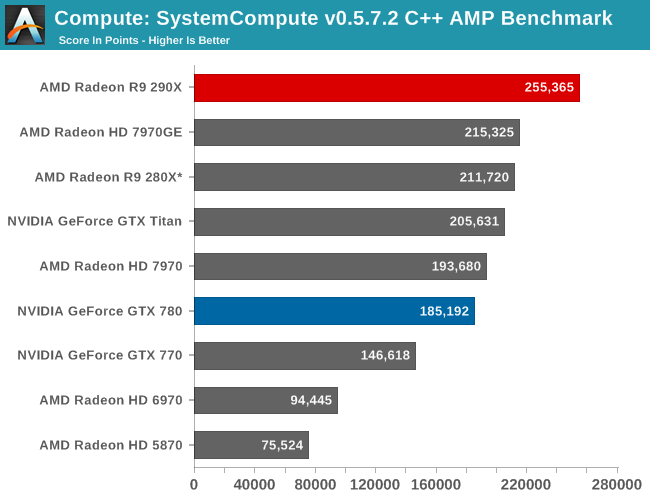
SystemCompute and the underlying C++ AMP environment scales relatively well with the additional CUs offered by 290X. Not only does the 290X easily surpass the GTX Titan and GTX 780 here, but it does so while also beating the 280X by 18%. Or to use AMD’s older GPUs as a point of comparison, we’re up to a 3.4x improvement over 5870, well above the improvement in CU density alone and another reminder of how AMD has really turned things around on the GPU compute side with GCN.










396 Comments
View All Comments
Blamcore - Friday, October 25, 2013 - link
Wow, I was just remarking yesterday that NV fanbois had sunk to the level of apple fanbois, when I was seeing the argument "you just like AMD because you can't afford NV" on a few boards. Now here is apple fanbois famous argument "my company is better because they have a higher profit margin" Gratz your unreasonable bias just went up a level!I know, you aren't a fanboy, you are really a business expert here to recommend that a company should gain market share by releasing a card roughly equal to what it's competitor had out for months and pricing it the same as they do! Maybe the could have asked 650 if they released it last January
puppies - Saturday, October 26, 2013 - link
R+D costs come from the sale price of the card. Are you tring to claim a $300 GPU costs $300 in materials? R+D costs also come from the fact that shrinking the process enables the manufacturer to get more cards per die each time.Look at Intel and AMD their chips don't go up in price each time they get faster, they stay at the same price point. The last 2 cards I have bought have been Nvidia but the next one will be AMD at this rate. I expect a 660TI to be faster and more energy efficient than a 560TI and at the same price point WHEN IT IS RELEASED and I think a lot of people are in the same boat. Nvidia is trying to push people into spending more each time they release a new model line up and it stinks.
I don't care if a 660 is faster than a 560TI, forcing people to move down the GPU lineup just smacks of NVIDIA price gouging.
Samus - Thursday, October 24, 2013 - link
I have to disagree with you Berzerker. Although his post clearly "overpromotes" the 290, it is incredible value when you consider it is faster and cheaper (by hundreds of dollars) than the Titan.-Geforce 660TI owner
Laststop311 - Thursday, October 24, 2013 - link
For people that value a quiet computer, this card is trashSpunjji - Friday, October 25, 2013 - link
For people that value a quiet computer, all stock coolers are useless.People that value a truly quiet computer won't even be playing at this end of the GPU market.
Samus - Friday, October 25, 2013 - link
This card is a great candidate for water cooling since the back of the PCB is essentially empty. Water cooling the face side is cheaper/easier, and this card can clearly use it.HisDivineOrder - Friday, October 25, 2013 - link
He didn't say "silent." He said "quiet." I'd argue the Titan/780/690 coolers were all "quiet," but not "silent."Since he said quiet, I don't think his expectation is unreasonable to expect a certain level of "quiet" at the $500+ range of discrete cards.
Nenad - Friday, October 25, 2013 - link
780 with stock cooler is not useless, and it IS quiet (it is not 'silent')BTW, going by posted numbers it seems 290x will be TWICE as noisy as GTX780 ?
ballfeeler - Thursday, October 24, 2013 - link
Methinks Berzerker7 is just salty and perhaps partial to nvidia. Nothing itchy wrote is inaccurate, including the $550 price that Salty-Berzerker7 claimed was $600.- Fastest card ? - yup
- Free game ? – yup
- Pooped all over titan ? –yup
Do not be salty mr. Berzerker7. AMD just roundhouse kicked nvidia square in the gonads with performance above Titan for half the price.
Shark321 - Thursday, October 24, 2013 - link
At 1080p it's actually slower than Titan if you average all reviews across the sites. With some reviews even slightly slower than the 780. It's also the loudest card ever produced after 30 minutes of playing (9,6 Sone in Battlefield 3 according to PCGamesExtreme). With this noise it's not acceptable and there will be no other coolers for the time being.